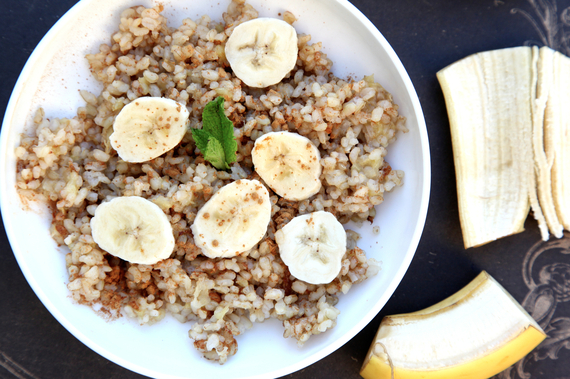It was beyond shocking to me to find found out as I was doing research for The 3-Day Reset that more than 60 percent of the foods we eat for breakfast are anchored refined sugar and refined flour. If you think about it, most standard items on our breakfast roster -- bagels, instant flavored oats, scones, pancakes, muffins, and most importantly cold cereals (the most popular breakfast choice in America) -- are made primarily of processed wheat and sugar. Sugar, of course, preys on our biological cravings for sweetness.
Commercial boxed breakfast cereals are some of the biggest culprits to the obstruction of our good health and wellness at the grocery store. First off, we might as well merge a vast majority of the cereal aisle with the dessert aisle because due to the high added sugar content, that's what most cold cereals boil down to these days -- dessert. And although many cereal boxes now tout high in "whole grains" labels, if you take the time to closely examine ingredient lists, you'll realize that although "whole grains" or "whole wheat" may in fact be listed, you'll likely also find a large amount of refined flour in the mix anyway (example: "wheat flour").
Even if you don't, often times the whole grains that are listed (such as oats and wheat) have been subjected to extrusion or "gun-puffing," a type of food processing procedure whereby whole grain kernels are forced out of small holes at high pressures to make puffed shapes like o's, or flakes, or shreds.
We also tend to forget that there's nothing fresh about boxed cereals. Who knows when the wheat berries or oats that were used in our cereals were harvested? Was it last month, or last year? What about the flour that was used? When exactly were those grains milled? Freshness is usually one of the best signs of nutrient-density, not to mention flavor.
Cereal wasn't always this way. Actually, up until the late 1800s, cold boxed cereal didn't exist. In fact, it wasn't until John Harvey Kellog -- in an effort to replicate granola and museli, health-promoting foods created in sanatoriums in the 19th century, experimented with wheat by boiling it, rolling it into thin flakes, then baking it, and finding that it could be packaged and preserved - that mass-market boxed cereal emerged. Before then we mainly ate cereal as a hot dish, what we refer to today as "porridge". Whole cereal grains (wheat, millet, rye, oats, rice, etc.), likely harvested locally, were slow-cooked with water. Refined sugar wasn't in the recipe.
It's time we take a conscious look at breakfast cereal in American and reset the way we know it, choose it, make it, and enjoy it.
There are plenty of ways we can eat cereal in a whole, nourishing, and flavorful format. We can start by exploring the large array of whole grains available to us -- not just oats and wheat. Many cultures around the globe depend on quinoa, millet, buckwheat, and rice to fuel their mornings. After years of recipe testing and experimenting with whole grains, whole ingredients, and unrefined sweeteners, I've come up with a few staple recipes I used regularly in my kitchen as substitutes for cold, boxed, standard cereals from the supermarket.
My family's all-time favorite is this Banana-Cinnamon Brown Rice Cereal that we can whip up in a matter of minutes! There is such a huge difference in flavor that comes from using fresh, whole, foods -- flavor that is incomparable to what you'll find buying cereal at a grocery store. For this recipe below, try making a few cups of rice the night before either on the stovetop or in a rice cooker! Enjoy eat whole and minimally processed (WAMP)!
BANANA-CINNAMON RICE CEREAL RESET RECIPE
SERVES: 1 to 2
TOTAL TIME: 10 MINUTES
INGREDIENTS
• Organic olive oil or grass-fed butter to coat pan
• 1 ripe banana, sliced into 1/4 inch thick discs
• 1 cup cooked brown rice
• 1/2 - 3/4 tsp ground cinnamon
• Unsweetened organic almond milk or similar plant-based milk
PROCEDURE
1. Heat the frying pan over low to medium heat and lightly coat the surface with a small amount of butter or oil.
2. Add banana slices, spreading them across the surface of the pan. Cook banana for 1 to 2 minutes until you start seeing a small amount of browning (caramelization) on the edges, then flip slices with a spatula, cooking for another couple of minutes. The banana slices will start melting and sticking together--this is OK.
3. Add the cooked rice to the pan and using the tip of the spatula, begin to mix rice with bananas, spreading the rice across the pan to ensure all the rice is thoroughly warmed. Cook another few minutes.
4. Add cinnamon and stir to combine. Remove, taste, and garnish the cereal with more cinnamon and add a small amount of milk if you wish and enjoy immediately!
###
I'd love to hear from you and help you on your journey to eating whole, minimally processed foods (WAMP) for life.
